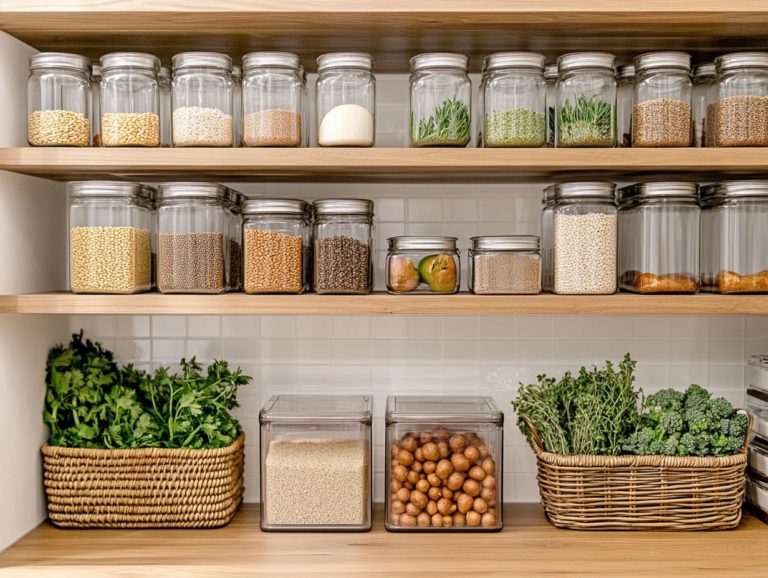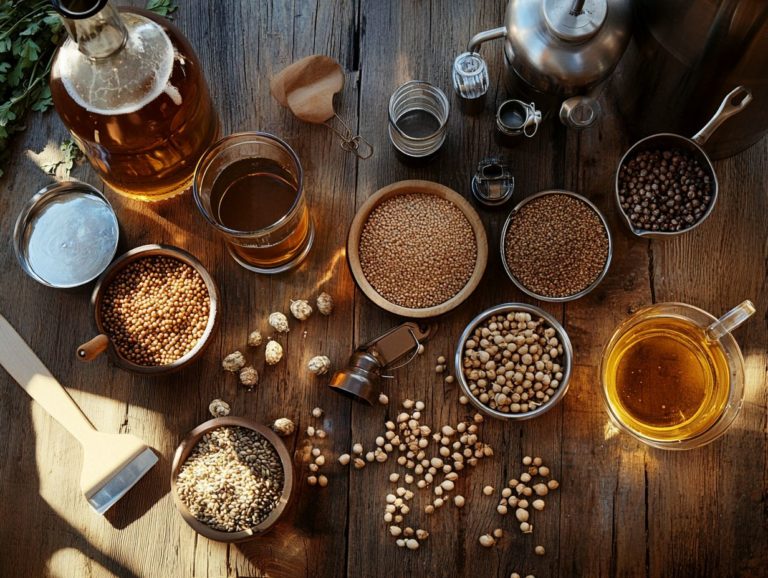How Do I Experiment with Flavors?
Contents
- Exploring Flavor: A Culinary Adventure
- Why Should I Experiment with Flavors?
- Expand Your Taste Palette
- What Are the Different Ways to Experiment with Flavors?
- Where Can I Find Inspiration for Flavor Experiments?
- Share Your Flavor Experiments!
- What Are Some Common Flavor Combinations to Try?
- Exploring Flavor Combinations
- Frequently Asked Questions
- How Do I Experiment with Flavors?
- What equipment do I need to experiment with flavors?
- How can I train my palate to better understand flavors?
- Is there a specific method for experimenting with flavors?
- Are there any guidelines for pairing flavors?
- What are some common mistakes people make when experimenting with flavors?
Exploring Flavor: A Culinary Adventure
Ready to unleash your inner chef? Experimenting with flavors transforms cooking into an engaging adventure. It’s an exhilarating journey that has the potential to transform your cooking and elevate every dining experience.
As you discover new combinations and tailor dishes to your personal taste, you’ll find yourself expanding your palate and uncovering delightful surprises along the way.
Whether you’re mixing ingredients, experimenting with various cooking techniques, or incorporating fresh herbs and spices, the possibilities for playing with flavor are virtually limitless.
This guide is designed to help you delve into the art of flavor experimentation, offering inspiration and suggesting fabulous combinations that will ignite your culinary creativity.
Key Takeaways:
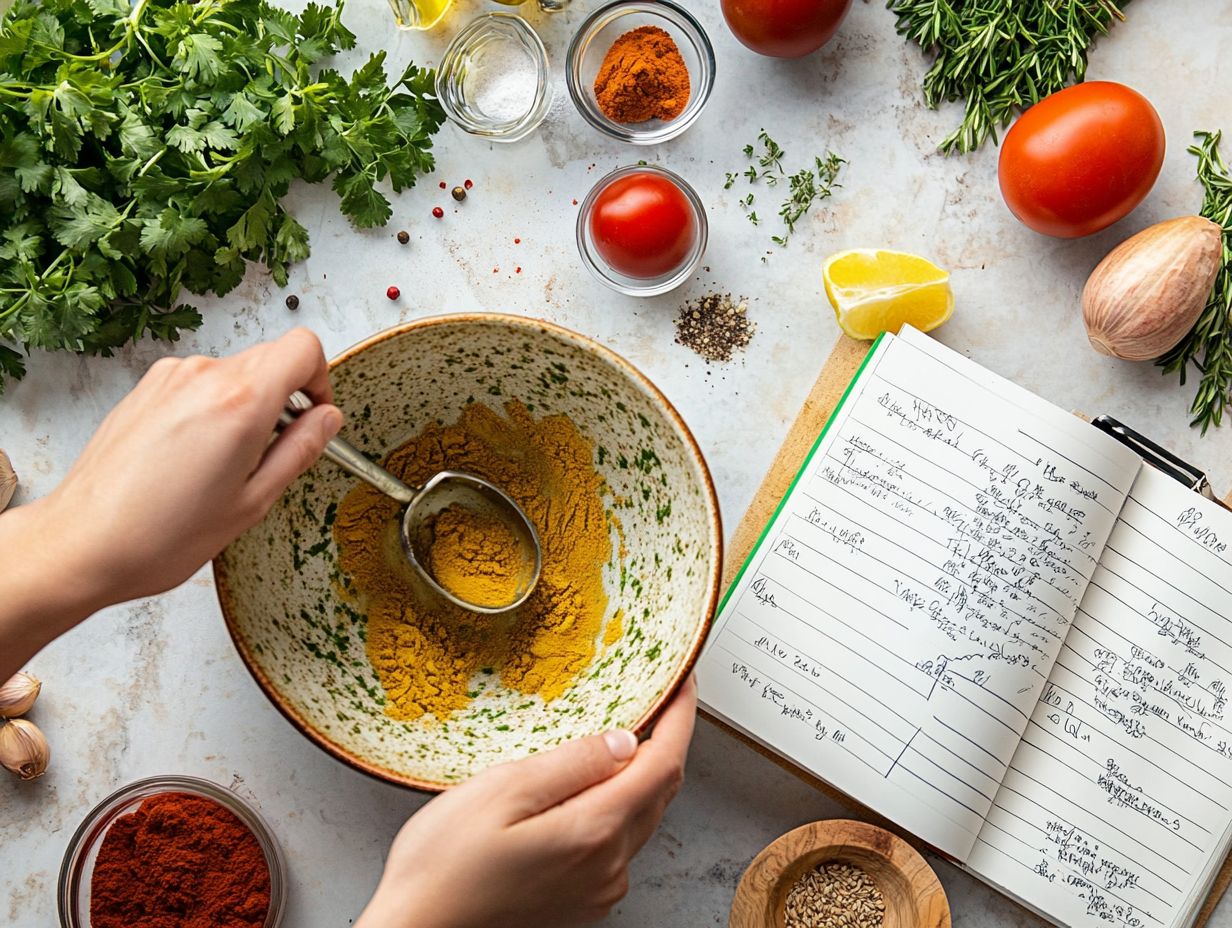
- Experimenting with flavors can lead to discovering new and exciting combinations of ingredients.
- Customizing flavors to your preferences can make your meals more enjoyable and satisfying.
- Trying new flavors can expand your taste palette and open up your senses to new culinary experiences.
Why Should I Experiment with Flavors?
Experimenting with flavors is nothing short of a delightful journey that elevates your culinary experience and encourages creativity and innovation in your kitchen. As you dive into flavor experiments, you have the opportunity to uncover new combinations that can turn ordinary dishes into great dishes.
Children can also partake in this thrilling exploration, using their taste buds to identify flavor profiles like sweet, sour, salty, bitter, and umami. This sensory adventure expands their understanding of food. It enables them to forge connections with an array of ingredients, herbs, and spices that add balance and depth to their cooking.
1. Discover New Combinations
Discovering new flavor combinations is an exhilarating journey in the realm of culinary experimentation. This invites you to create innovative dishes that surprise and delight the palate.
There are countless ways for you to unveil these culinary treasures, starting with an array of cooking techniques that can transform familiar ingredients into extraordinary flavors. For example, by employing techniques like sous-vide (a cooking technique that involves vacuum-sealing food and cooking it in a water bath at a precise temperature) or smoking, you can introduce depth and complexity that elevate your dish to new heights. Pairing unexpected ingredients think sweet fruits mingling with savory proteins can lead to delightful surprises that tantalize the taste buds.
Both chefs and home cooks have the opportunity to play with diverse flavor profiles by incorporating spices and herbs, while also experimenting with sour flavors, sweetness, and umami. By exploring these methods, you can craft innovative recipes that not only satisfy but also challenge traditional notions of taste, making your culinary creations truly memorable.
2. Customize to Your Preferences
Customize flavors to match your personal preferences for a more satisfying meal. This allows you to create dishes that truly resonate with your unique taste, resulting in a dining experience that is far more enjoyable.
For the food enthusiast in you, finding the perfect balance between sweet, sour, and salty is crucial in crafting a memorable meal. By experimenting with these components, you can elevate a dish from the ordinary to the extraordinary. Adjusting the sweetness of a sauce can enhance its depth, while a splash of acidity can brighten flavors and cut through richness.
Understanding the role of salt not only enhances the overall flavor but also amplifies the complexity of each ingredient, bringing your culinary creations to life.
By carefully tweaking these elements, you can achieve a harmonious flavor profile, ensuring that every bite is as delightful as the last.
Expand Your Taste Palette
Expanding your taste palette means diving into a world of diverse flavors and ingredients that challenge and excite your senses. Ultimately, this leads to a richer culinary experience.
By introducing children to a variety of cooking styles and exotic ingredients, they not only develop a broader understanding of food but also engage their taste buds and noses in meaningful ways. This delightful journey into new flavors sparks creativity in the kitchen, encouraging a willingness to experiment and try new recipes.
As kids taste and savor unfamiliar ingredients, they enhance their sensory experience and cultivate a deeper appreciation for the nuances of flavor and texture.
This kind of exposure sets the stage for healthier eating habits and fosters a lifelong love for cooking.
What Are the Different Ways to Experiment with Flavors?
You have countless opportunities to experiment with flavors, enabling you to transcend the confines of traditional cooking and delve into the expansive world of taste.
By embracing innovative methods and unique ingredients, you can truly redefine your culinary experience and tantalize your palate.
1. Mixing Different Ingredients
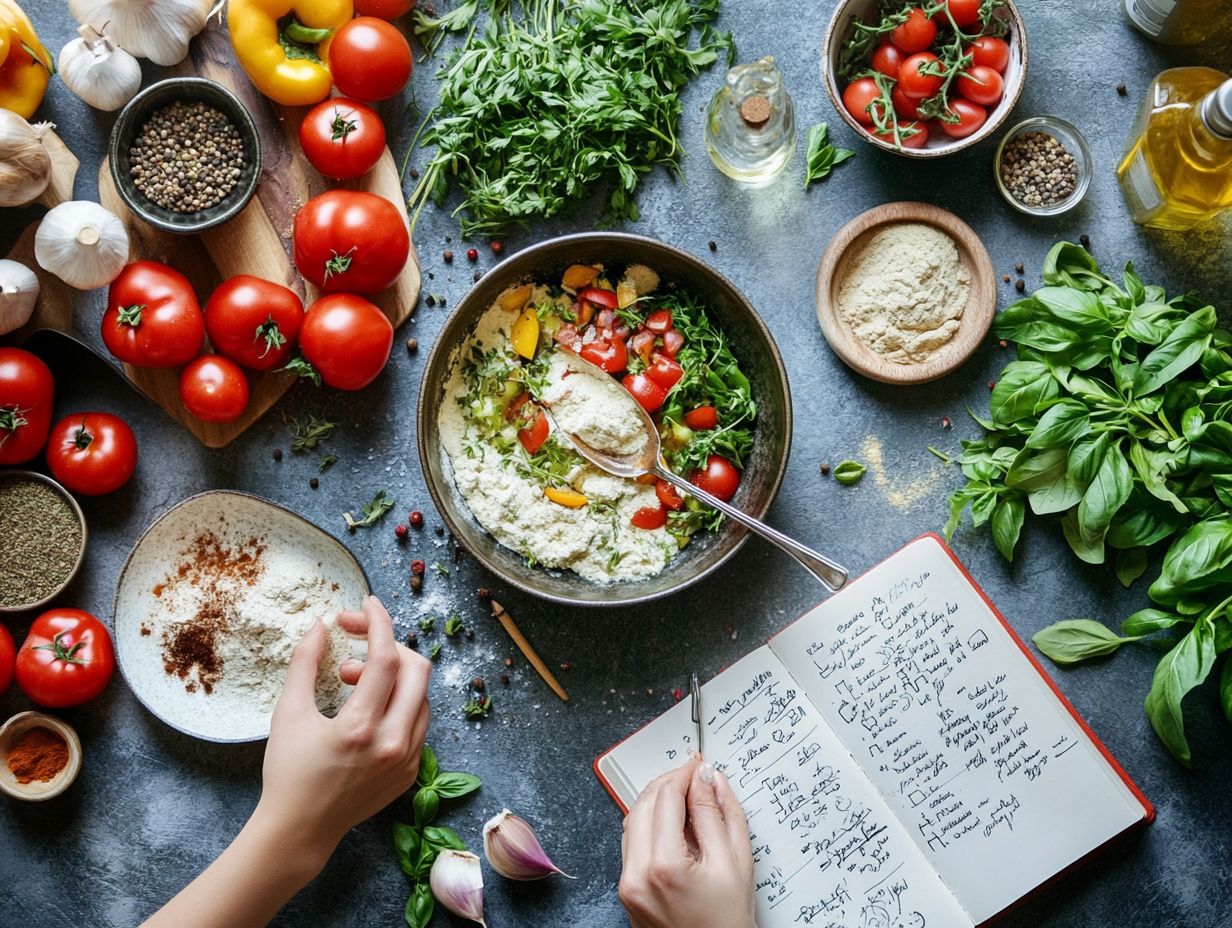
Mixing different ingredients is essential for flavor experimentation. It gives you the power to craft unique dishes that tantalize the taste buds.
This creative process invites both chefs and home cooks to explore endless possibilities within recipes, resulting in innovative flavor profiles that are sure to surprise and delight.
For example, a simple combination of sweet and savory can lead to mouthwatering dishes like bacon-wrapped dates or a delectable peach salsa that pairs beautifully with grilled fish. By incorporating unexpected ingredients such as herbs and spices, you can elevate your meals from ordinary to extraordinary.
Think of fusion cuisines, like adding Thai basil to pasta or sprinkling cilantro over traditional tacos. By embracing the art of mixing diverse flavors, you can redefine your culinary adventures and impress your guests with your imaginative gastronomic creations.
2. Trying Different Cooking Techniques
Exploring various cooking techniques can profoundly transform the taste and texture of your dishes, leading to innovative creations that embody a unique flavor chemistry.
Techniques like roasting, steaming, and sous-vide each possess distinct transformative qualities that elevate ingredients and allow for intricate layering of flavors.
Take roasting, for example; it caramelizes sugars and enhances the natural sweetness of food, giving it a depth that is difficult to replicate. Steaming, on the other hand, preserves moisture and nutrients, resulting in vibrant colors and fresh flavors that uphold the dish’s integrity.
Then there’s sous-vide, a cooking method that involves sealing food in a bag and cooking it to very precise temperatures. This merges precision cooking with temperature control, enabling flavors to meld seamlessly and creating a harmonious balance.
These methods not only highlight culinary innovation but also encourage you to experiment in the kitchen, inviting diners to savor food in new and exhilarating ways.
3. Adding Spices and Herbs
Adding spices and herbs is a simple yet powerful way to enhance flavors, transforming ordinary dishes into extraordinary culinary experiences.
As you explore the world of flavors, you’ll quickly discover that spices and herbs play a pivotal role in elevating taste profiles. For instance, just a sprinkle of cumin can lend incredible depth to a vegetable stew, while the fresh zest of basil paired with tomatoes creates a classic combination that sings of summer.
Similarly, the warm embrace of cinnamon alongside the sweetness of apples can elevate a simple dessert into a beloved favorite.
These combinations do more than just enhance taste; they create a harmonious bouquet of aromas that tantalize your senses, transforming every meal into a delightful occasion.
4. Combining Sweet and Savory
Combining sweet and savory flavors creates a dynamic contrast that delights your palate and sparks culinary innovation. This intriguing blend not only elevates the overall taste but also opens the door to a realm of culinary possibilities.
As you explore, consider how many chefs play with popular combinations like bacon and maple syrup or peach chutney alongside grilled chicken. These examples showcase how contrasting tastes can harmonize beautifully. Such innovative flavor pairings often result in unique dishes that challenge the traditional norms of gastronomy, which is the study of food and cooking.
When sweet elements like honey or fruits meet savory ingredients such as cheese or herbs, don t miss out on the explosion of flavors. This encourages you, as a food lover, to venture beyond your usual preferences, ultimately enriching your dining experience.
Where Can I Find Inspiration for Flavor Experiments?
You can uncover inspiration for your flavor experiments from a multitude of sources, including cookbooks, food blogs, and the diverse cultural influences that intricately weave together the culinary practices across the globe.
1. Cookbooks and Recipes
Cookbooks are an exceptional resource for you as a culinary enthusiast. They offer a treasure trove of recipes and techniques that inspire flavorful experiments in your kitchen.
Whether you re diving into the vibrant world of molecular gastronomy, a modern way of cooking that uses science to create new textures and flavors, or mastering the art of traditional fermentation, these books provide invaluable insights that can transform your cooking experience.
Take ‘Salt, Fat, Acid, Heat‘ by Samin Nosrat, for example. It empowers you with essential culinary techniques, enabling you to enhance your dishes with both precision and originality. This exploration will make your cooking more experimental and delicious.
‘Modernist Cuisine‘ dares you to push the boundaries of conventional cooking, inviting chefs of all skill levels to experiment with innovative methods, unique ingredients, and rich flavor profiles. By tapping into these resources, you can elevate your culinary game, ensuring that every meal becomes a canvas for your creativity and exploration. This approach will inspire you to create culinary masterpieces.
2. Restaurants and Food Blogs
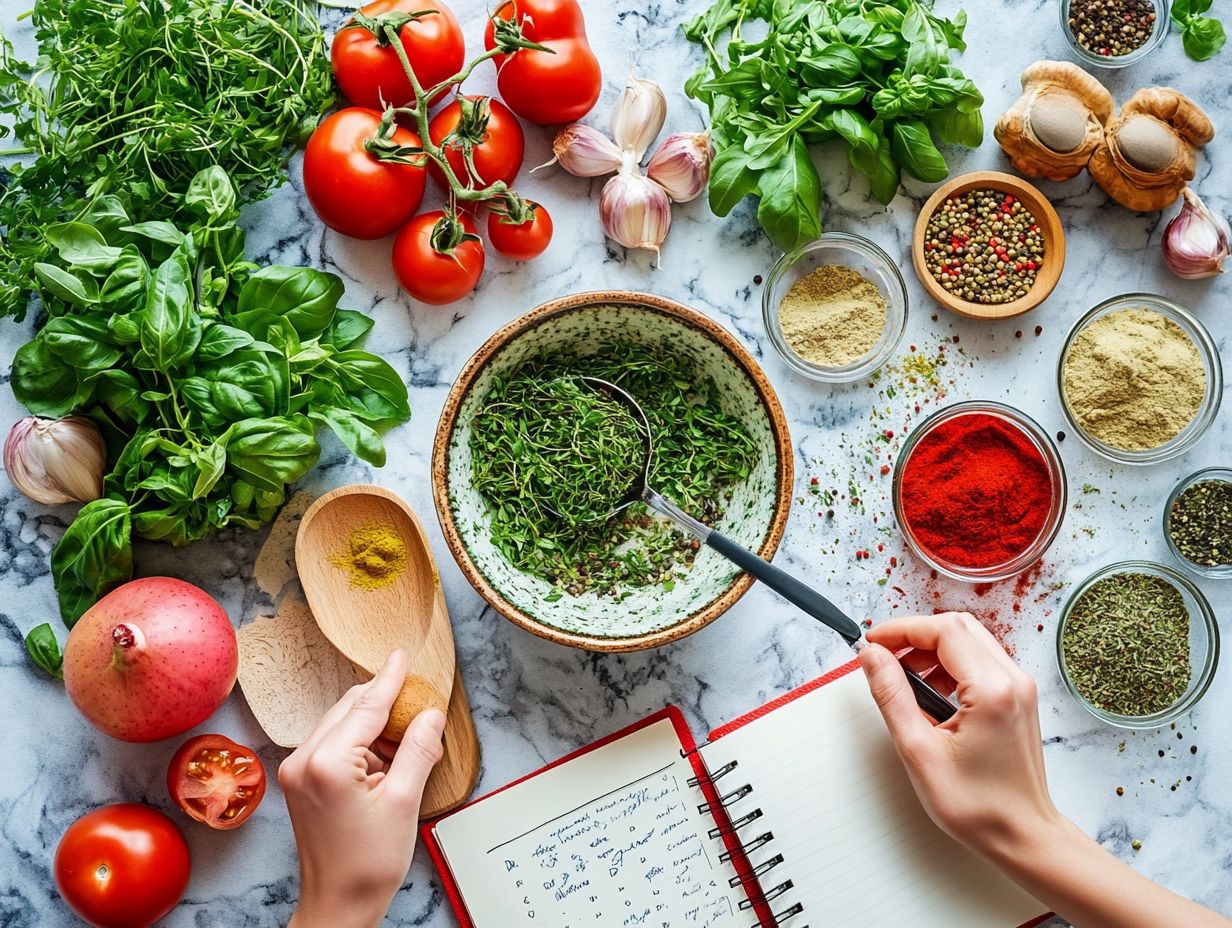
Restaurants and food blogs are treasure troves of culinary trends and inspiration, showcasing innovative dishes that celebrate the art of flavor experimentation. These platforms serve as a canvas for both chefs and home cooks who boldly push the boundaries of taste.
Take, for example, the rise of fusion cuisine. You might find exciting combinations like Korean tacos and sushi burritos, effortlessly blending elements from diverse culinary heritages.
The surge in plant-based cooking has ignited trends centered around umami-rich flavors, with dishes such as BBQ jackfruit sliders becoming staples in the modern diet. This trend not only offers delicious dishes but also encourages culinary innovation with ingredients like fruits and vegetables.
By sharing their experiences and unique recipes, food bloggers motivate you to venture into new taste dimensions, inviting you to embark on your own flavorful adventures.
We invite you to share your own flavor experiments with us. What combinations have you tried? What unique dishes have you created? Join the conversation and inspire others!
3. Cultural Influences
Cultural influences significantly shape your flavor profiles, introducing a vibrant array of ingredients and techniques that inspire culinary innovation.
As you explore cuisines from around the globe, you encounter unique combinations of spices, herbs, and cooking methods that invite you to experiment boldly with flavors. Take, for example, the bold spices of South Asian dishes; they often harmoniously blend with the umami-rich flavors typical of East Asian cooking. This fusion results in exciting new dishes that tantalize your taste buds.
This interplay not only underscores the importance of cultural diversity in culinary practices but also illustrates how these blended flavor profiles can evoke nostalgia, tell stories, and create unforgettable dining experiences. As you, whether as a chef or a home cook, draw inspiration from various culinary traditions, the fusion of flavors continually expands your culinary landscape, opening up new avenues for creativity and delight. This process highlights the role of sensory organs like taste receptors in perceiving complex flavors.
What Are Some Common Flavor Combinations to Try?
You have a world of common flavor combinations at your fingertips, each one capable of elevating your culinary creations. Embrace the spirit of experimentation as you enhance the taste profiles of your delicious dishes.
1. Sweet and Spicy
Think about the way jelly beans come in a variety of flavors; mixing sweet and spicy can be just as fun and unexpected!
The delightful combination of sweet and spicy flavors creates a captivating balance that truly excites your taste buds and fuels culinary creativity. This balance leverages the chemistry of sweetness and spiciness to create unique taste experiences.
You can see this harmonious blend in dishes like mango salsa, where the natural sweetness of ripe mangoes is beautifully enhanced by the zest of jalape os. Consider Asian cuisine, where sweet chili sauce artfully marries sugar and chili peppers, making it a perfect glaze for grilled meats or a tempting dipping sauce for crispy spring rolls.
Regarding desserts, think of chocolate chili brownies that introduce an unexpected yet tantalizing twist, demonstrating how these flavors can elevate even the sweetest treats. Such inventive pairings not only please the palate but also inspire you to experiment further, incorporating a myriad of ingredients that push the boundaries of traditional flavor profiles.
2. Salty and Sour
Consider how certain chemicals in our saliva react with salty and sour foods to enhance the overall flavor experience.
Combining salty and sour flavors offers a dynamic contrast that elevates the overall taste experience of your dish. This intriguing blend creates a balance that tantalizes your palate, making each bite feel more exciting. This type of flavor chemistry allows you to experiment with culinary techniques and cooking methods to achieve the perfect balance.
Take, for instance, the classic Thai papaya salad, where the saltiness of fish sauce harmonizes beautifully with the tanginess of lime juice, resulting in a vibrant explosion of flavors. Similarly, consider the union of briny olives and tangy citrus in Mediterranean cuisine, which demonstrates how these contrasting elements can transform simple ingredients into a gourmet delight.
Embracing these flavor profiles not only enhances your meals but also opens the door to endless culinary creativity.
Exploring Flavor Combinations
Get ready to elevate your cooking! Experimenting with flavors is fun and creative. In this guide, we ll explore various flavor combinations that can transform your dishes into memorable culinary experiences.
3. Creamy and Tangy
Blending yogurt with tangy flavors offers a delicious and refreshing contrast in many dishes.
The creamy and tangy flavor profile you re working with offers a delightful contrast that can elevate your dishes, crafting memorable taste experiences. This combination shows how to pair different flavors and ingredients, creating a unique dining experience.
This harmonious blend can turn simple ingredients into extraordinary meals. Imagine classic dishes like creamy lemon risotto or tangy yogurt dips paired with fresh vegetables! The rich, velvety texture of cream complements the zesty brightness of citrus or the sharpness of vinegar, tantalizing your palate with each bite.
Now, picture a pasta dish drizzled with creamy mushroom sauce; a splash of balsamic vinegar can enhance it even further, creating an intricate dance of flavors that keeps your taste buds engaged. Similarly, crumbling tangy goat cheese atop a smooth beet salad introduces layers of complexity, illustrating how these contrasting profiles can truly elevate your overall dining experience.
4. Earthy and Nutty
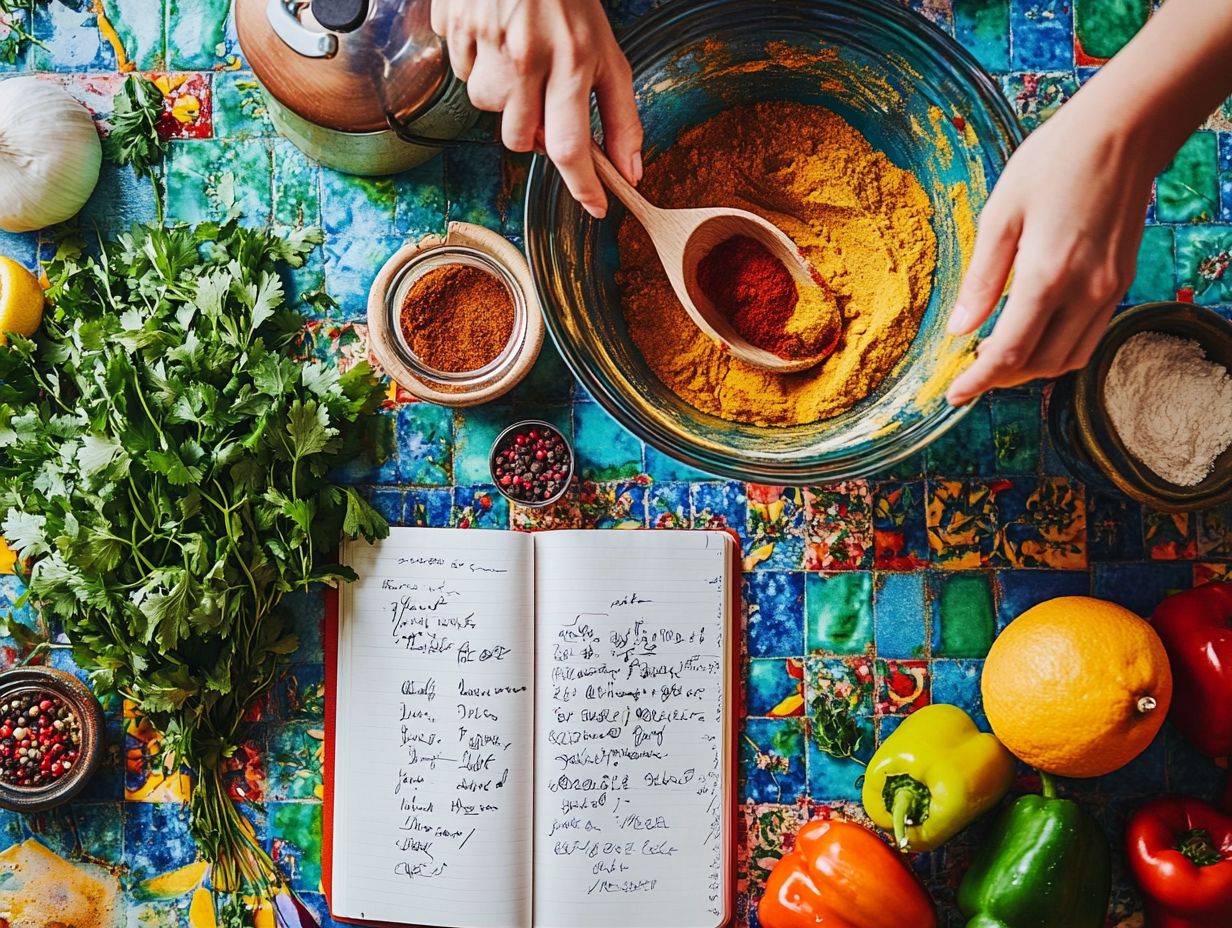
Kids often enjoy experimenting with earthy and nutty flavors by adding nuts to simple salads or snacks.
Earthy and nutty flavor combinations infuse your dishes with depth and richness, beckoning you to embrace experimentation and innovation in the kitchen.
These flavors have the power to elevate your meals in unexpected ways, transforming simple dishes into gourmet experiences. Imagine adding toasted walnuts to a roasted beet salad; it not only enhances the texture but also introduces a delightful contrast to the beets’ earthiness. This type of experimentation highlights the potential for culinary innovation in everyday dishes.
Picture a creamy risotto enriched with earthy mushrooms and generously sprinkled with nutty parmesan, creating a harmonious balance that dances on the palate. Such inventive pairings invite you to explore a diverse array of ingredients, leading to unique masterpieces that embody the comforting essence of nature’s bounty.
5. Smoky and Savory
Using a stovetop smoker can help you achieve a robust smoky flavor that perfectly complements savory dishes.
You can achieve these delectable profiles through several methods, such as incorporating smoked ingredients, charred vegetables, or smoked salts and oils. Techniques like roasting, grilling, or using a stovetop smoker allow for a beautiful infusion of depth and complexity, bringing out the natural umami a savory taste that enhances flavors in your ingredients. The interplay of these flavors has the power to elevate simple meals into rich and satisfying dining experiences.
By diving into these exciting methods, you ll embark on culinary discoveries, transforming smoky and savory combinations into a beloved choice for both your home cooking and any aspiring chefs you might know.
Don’t miss this insightful video from Eric H. Chudler for a deeper dive into the science of flavor.
Frequently Asked Questions
How Do I Experiment with Flavors?
Experimenting with flavors is a fun and creative way to enhance your cooking! Here are some frequently asked questions about how to get started. Inspired by sources like KidsHealth, you can begin to understand how flavors work.
What equipment do I need to experiment with flavors?
You don’t need any special tools to experiment with flavors. However, having a variety of spices, herbs, and seasonings on hand can make it easier to mix and match different flavors. Consider exploring experimental cuisine techniques to create unique dishes.
How can I train my palate to better understand flavors?
One way to train your palate is to try different foods and seasonings on their own. Pay attention to the flavors and textures, and make note of what you like and don’t like. You can also try blind taste tests to challenge yourself and expand your palate. Engaging your taste buds with a variety of flavors can broaden your culinary horizons.
Experimenting with flavors not only makes cooking exciting but also allows for creativity in every dish you prepare!
Is there a specific method for experimenting with flavors?
There is no right or wrong way to experiment with flavors. Start by adding small amounts of different seasonings to a dish and adjust them to your taste.
You can also try combining different flavors and ingredients to create unique dishes. Consider using a blindfold to focus solely on aromas and textures, further enhancing your sensory experience.
Are there any guidelines for pairing flavors?
While there are no strict rules, there are some general guidelines for pairing flavors. For example, citrus flavors often pair well with seafood.
Creamy flavors go well with rich and hearty dishes. However, don’t be afraid to think outside of the box and try unexpected flavor combinations.
What are some common mistakes people make when experimenting with flavors?
One common mistake is over-seasoning or using too many strong flavors in one dish. It’s important to balance flavors and not overpower them.
Another mistake is not being open-minded and sticking to the same familiar flavors. Don t worry about making mistakes; embrace the thrill of experimenting with bold flavors!
Engage your taste buds with a variety of flavors like sweet, sour, salty, bitter, and umami. Get in the kitchen today and start your flavor adventure!

